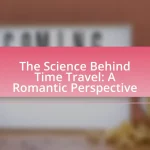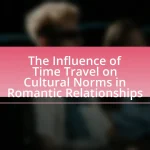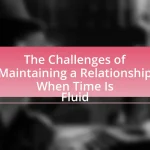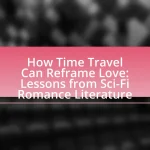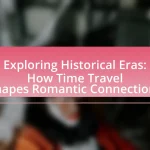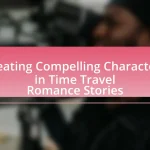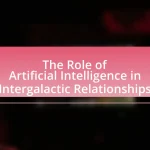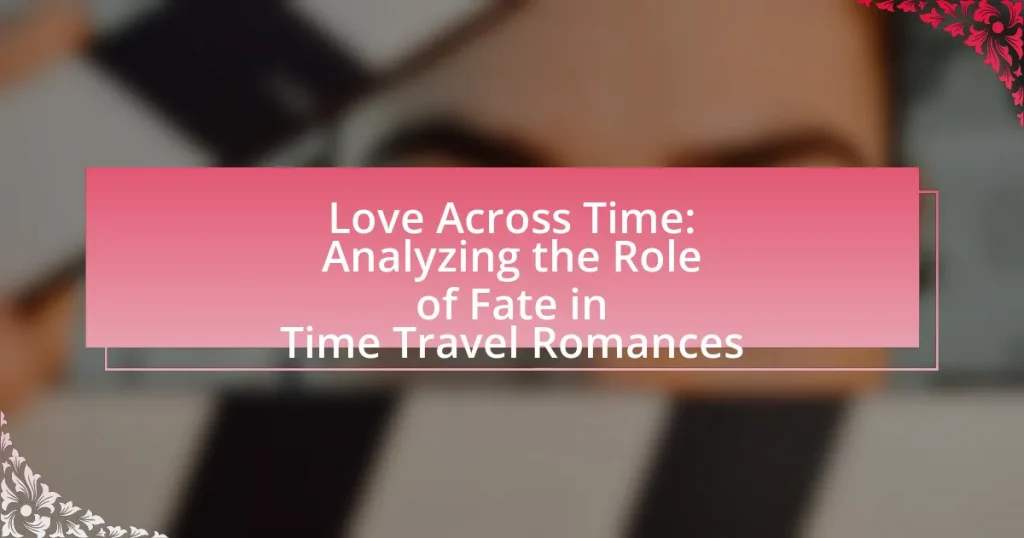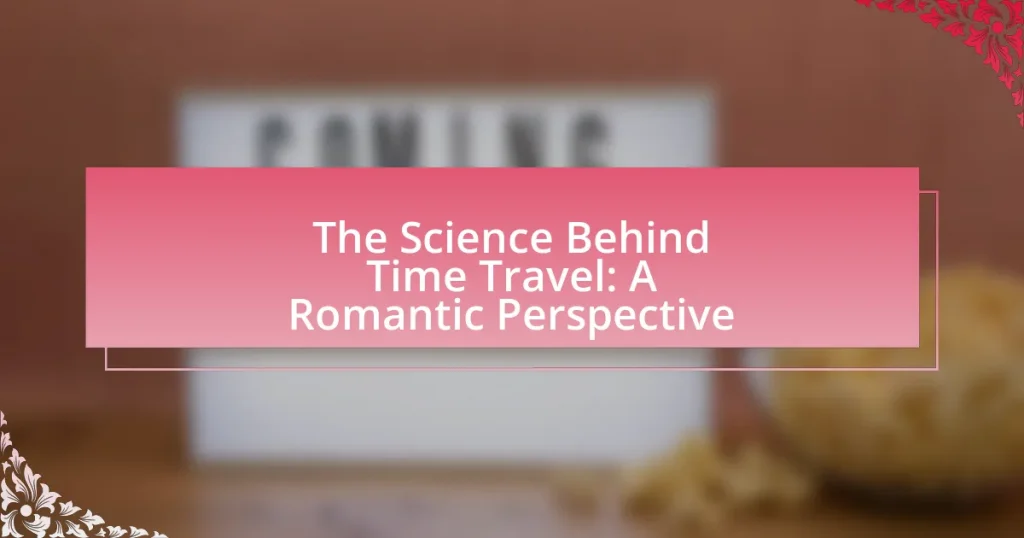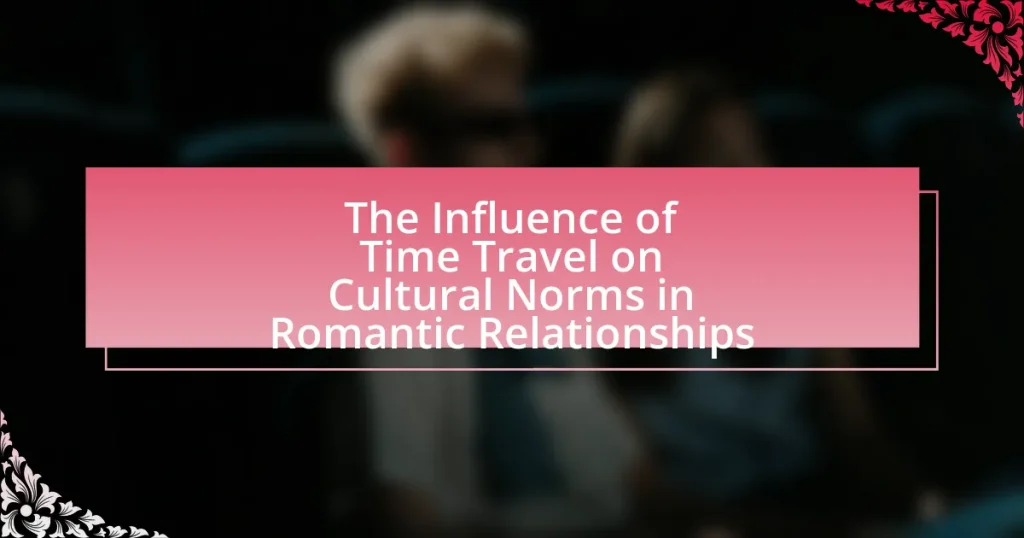The article “Love Across Time: Analyzing the Role of Fate in Time Travel Romances” examines the significance of love within the context of time travel narratives, emphasizing how it transcends temporal boundaries and influences character development. It explores the themes of fate, predestination, and the emotional complexities that arise from time travel, highlighting how these elements shape romantic relationships. Key discussions include the impact of different time travel mechanisms on love stories, the emotional dynamics involved, and the moral dilemmas characters face. Additionally, the article analyzes notable examples and contemporary interpretations of time travel romances, providing insights into how these narratives reflect real-life relationship dynamics and offer practical lessons for navigating love.
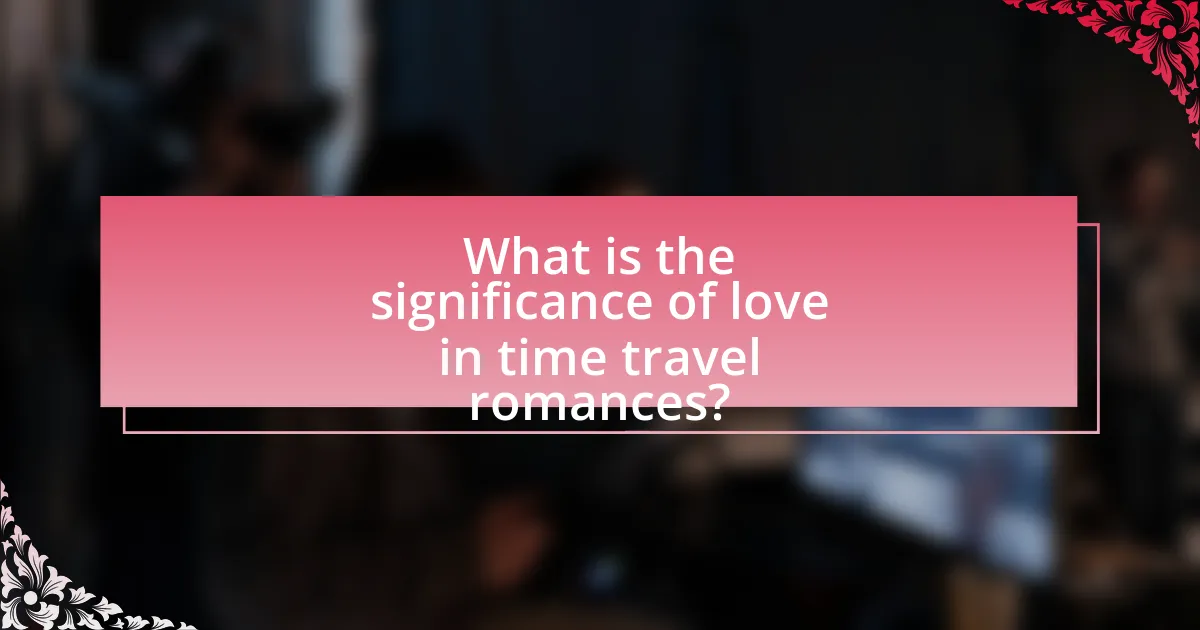
What is the significance of love in time travel romances?
The significance of love in time travel romances lies in its ability to transcend temporal boundaries, creating emotional stakes that resonate across different eras. Love serves as a catalyst for character development, driving protagonists to confront their pasts or futures, often leading to transformative journeys. For instance, in works like “The Time Traveler’s Wife” by Audrey Niffenegger, the love between the characters is portrayed as a force that defies the constraints of time, emphasizing the idea that true connections can endure despite physical separation. This narrative framework illustrates how love not only motivates characters but also highlights themes of fate and destiny, suggesting that some relationships are meant to be, regardless of the challenges posed by time travel.
How does fate influence romantic relationships in time travel narratives?
Fate significantly influences romantic relationships in time travel narratives by establishing predetermined outcomes that characters cannot escape. In these stories, the concept of fate often manifests through the idea that certain events are destined to occur, regardless of the characters’ attempts to alter them. For instance, in the film “The Time Traveler’s Wife,” the protagonist’s time travel is governed by fate, leading him to meet his love interest at specific moments in her life, reinforcing the notion that their relationship is meant to be. This intertwining of fate and romance creates a compelling dynamic where characters grapple with the tension between free will and destiny, ultimately suggesting that love transcends time and is an inescapable force.
What are the key themes of fate in time travel romances?
The key themes of fate in time travel romances include predestination, the inevitability of love, and the intertwining of past and future. Predestination suggests that characters are meant to meet regardless of time, emphasizing that their love transcends temporal boundaries. The inevitability of love highlights that no matter the obstacles or time periods, the connection between characters remains strong and unbreakable. Additionally, the intertwining of past and future illustrates how actions in one time period can affect relationships in another, reinforcing the idea that fate plays a crucial role in shaping their destinies. These themes are prevalent in various narratives, showcasing how love can endure through time’s complexities.
How do characters perceive fate in their romantic journeys?
Characters in time travel romances often perceive fate as a predetermined force that guides their romantic journeys. This perception is influenced by the belief that their encounters and relationships are orchestrated by a higher power or the fabric of time itself. For instance, characters may interpret significant coincidences or time loops as signs that they are meant to be together, reinforcing the idea that their love is destined. This notion is supported by narratives where characters experience repeated timelines, suggesting that fate plays a crucial role in shaping their romantic outcomes.
What role does time travel play in shaping love stories?
Time travel significantly shapes love stories by introducing complex narratives that explore the themes of fate, choice, and the consequences of actions across different timelines. In time travel romances, characters often navigate alternate realities or historical contexts, which allows for unique interactions and emotional depth that challenge conventional relationship dynamics. For instance, in the film “The Time Traveler’s Wife,” the protagonist’s involuntary time travel complicates his relationship, emphasizing how time can alter love’s trajectory and the impact of fate on personal connections. This interplay between time and love creates a rich tapestry of storytelling that examines how relationships can endure or falter under the pressures of temporal displacement.
How does time travel create obstacles for love?
Time travel creates obstacles for love by introducing complexities such as altered timelines and the potential for paradoxes. These complexities can lead to situations where individuals may not meet or form connections as they originally did, disrupting the natural progression of their relationship. For instance, if one partner travels to a different time period, they may inadvertently change events that affect their love interest’s life, creating emotional distance or even preventing their relationship from ever occurring. Additionally, the existence of multiple timelines can result in conflicting realities, where one version of a character may have different experiences and feelings than another, complicating their ability to connect meaningfully.
What are the emotional impacts of time travel on relationships?
Time travel can significantly alter emotional dynamics in relationships, often leading to feelings of longing, confusion, and existential distress. When individuals experience time travel, they may encounter past or future versions of their partners, which can create emotional turmoil as they grapple with the implications of altered timelines and the potential loss of shared experiences. For instance, a character who travels to the past may struggle with the knowledge of future events that could change their current relationship, leading to anxiety and uncertainty about their partner’s fate. This emotional complexity is evident in narratives like “The Time Traveler’s Wife,” where the protagonist’s time travel disrupts their relationship, causing both joy and heartache. Such stories illustrate how time travel can evoke deep emotional responses, highlighting the fragility of love when faced with the paradoxes of time.
Why do audiences resonate with time travel romances?
Audiences resonate with time travel romances because they explore the complexities of love transcending temporal boundaries. This genre allows viewers to engage with the idea of fate, as characters often face challenges that test their relationships across different timelines. The emotional stakes are heightened when love is juxtaposed with the unpredictability of time, creating a compelling narrative that captivates audiences. Research indicates that stories involving time travel often evoke a sense of nostalgia and longing, which enhances emotional engagement. For instance, a study published in the Journal of Popular Culture highlights that narratives featuring time travel frequently tap into universal themes of love and loss, making them relatable and impactful for diverse audiences.
What psychological factors contribute to the appeal of these stories?
The psychological factors contributing to the appeal of time travel romances include escapism, emotional connection, and the exploration of fate. Escapism allows individuals to immerse themselves in fantastical narratives that transcend reality, providing a temporary escape from everyday life. Emotional connection is fostered through relatable characters and their struggles, which resonate with the audience’s own experiences of love and longing. Furthermore, the exploration of fate engages viewers by presenting the idea that love can transcend time and space, creating a sense of hope and possibility. Research indicates that narratives involving fate can enhance emotional engagement, as they tap into fundamental human desires for connection and meaning in relationships.
How do cultural contexts influence the reception of time travel romances?
Cultural contexts significantly influence the reception of time travel romances by shaping audience expectations, values, and interpretations of love and fate. For instance, in cultures that prioritize collectivism, time travel narratives may emphasize familial bonds and communal responsibilities, affecting how romantic relationships are perceived within the story. Conversely, in individualistic cultures, the focus may shift to personal choice and self-fulfillment in romantic pursuits, altering the narrative’s emotional impact. Research indicates that cultural narratives around love, such as those found in literature and media, dictate how audiences relate to characters and their journeys, thus influencing the overall reception of the genre.
How can we connect the themes of fate and love in time travel narratives?
The themes of fate and love in time travel narratives are interconnected through the idea that love transcends temporal boundaries, often suggesting that destined relationships can withstand the complexities of time. In many time travel stories, characters are portrayed as being fated to meet or be together despite the obstacles posed by different timelines, reinforcing the notion that true love is preordained. For example, in the film “The Time Traveler’s Wife,” the protagonist’s involuntary time travel leads him to his soulmate, illustrating how their love is depicted as inevitable, regardless of the challenges they face. This narrative structure emphasizes that fate plays a crucial role in guiding characters toward their destined partners, thereby intertwining love and fate as central themes in time travel narratives.
What are the common tropes found in time travel romances?
Common tropes found in time travel romances include the “star-crossed lovers” theme, where characters from different time periods fall in love despite obstacles. Another prevalent trope is the “time loop,” where characters relive the same moments to alter outcomes in their relationships. Additionally, the “historical figure romance” trope features protagonists who fall in love with real historical figures, blending fiction with history. The “fate vs. free will” theme often explores whether love can transcend time and predetermined paths. These tropes are supported by numerous works in literature and film, such as “Outlander” and “The Time Traveler’s Wife,” which illustrate these recurring elements in their narratives.
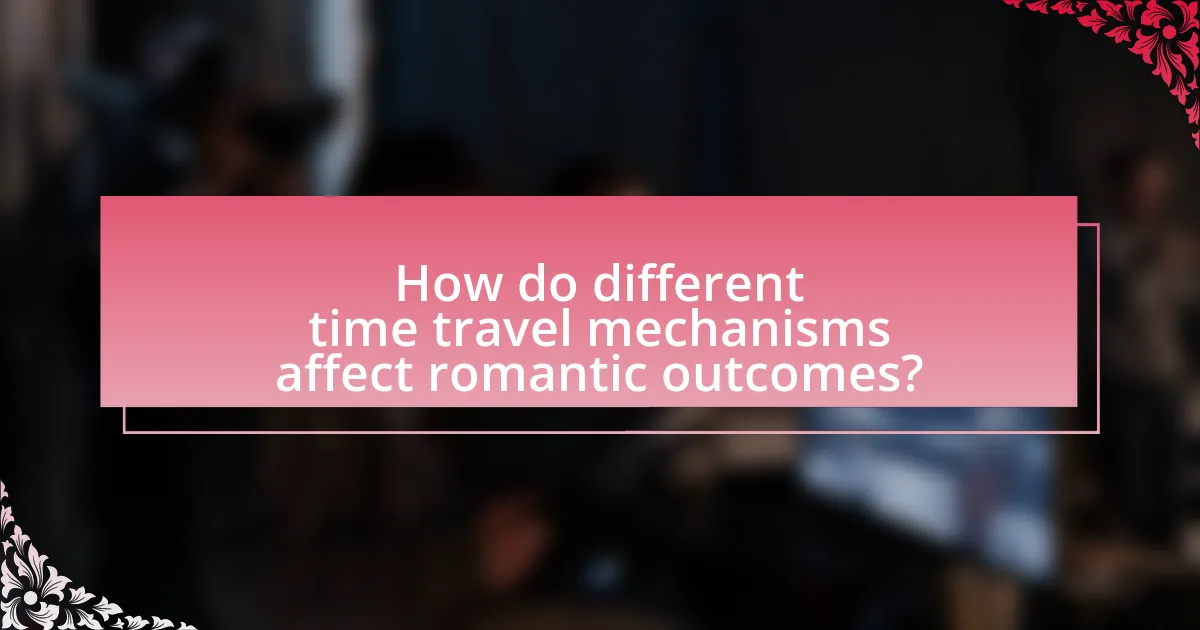
How do different time travel mechanisms affect romantic outcomes?
Different time travel mechanisms significantly influence romantic outcomes by altering the dynamics of relationships and the potential for fate. For instance, in narratives where time travel allows for multiple timelines, characters can explore various romantic possibilities, leading to complex emotional entanglements and the chance to rectify past mistakes. In contrast, mechanisms that involve fixed timelines often create a sense of inevitability, where characters are bound to their fates, limiting their romantic choices.
Evidence from literature, such as “The Time Traveler’s Wife” by Audrey Niffenegger, illustrates how time travel can complicate love, as the protagonist’s involuntary time shifts create challenges in maintaining a stable relationship. Similarly, in “Back to the Future,” the ability to change past events leads to significant alterations in romantic relationships, showcasing how time travel can serve as a catalyst for both conflict and resolution in love. Thus, the type of time travel mechanism employed directly shapes the romantic narrative and outcomes, influencing character development and emotional depth.
What are the various types of time travel depicted in literature and film?
Various types of time travel depicted in literature and film include linear time travel, where characters move forward or backward in a straightforward manner; parallel universes, which involve alternate timelines created by time travel; and time loops, where characters repeatedly experience the same period. Linear time travel is exemplified in works like “The Time Machine” by H.G. Wells, where the protagonist travels to the future. Parallel universes are illustrated in films like “Sliding Doors,” where different choices lead to divergent outcomes. Time loops are famously portrayed in “Groundhog Day,” where the main character relives the same day until he learns a lesson. Each type serves different narrative purposes and explores themes of fate and choice, particularly in time travel romances.
How does time travel via technology differ from magical time travel?
Time travel via technology is based on scientific principles and mechanisms, while magical time travel relies on supernatural forces or abilities. Technological time travel often involves devices or machines, such as time machines or wormholes, which are grounded in theoretical physics, as seen in works like H.G. Wells’ “The Time Machine.” In contrast, magical time travel is typically portrayed in fantasy literature, where characters may possess innate powers or use spells to traverse time, as exemplified in stories like “Harry Potter.” This distinction highlights that technological time travel adheres to logical frameworks and potential scientific validation, whereas magical time travel operates outside the bounds of scientific explanation.
What implications do different time travel methods have on fate?
Different time travel methods significantly influence the concept of fate by altering the timeline and the events that shape individual destinies. For instance, in the “fixed timeline” approach, any attempt to change the past results in events unfolding as they were originally meant to, suggesting that fate is immutable. Conversely, the “multiverse” theory allows for the creation of alternate realities, where changes in the past lead to different outcomes, indicating that fate can be flexible and subject to individual choices. This dichotomy illustrates how the mechanics of time travel can either reinforce or challenge the notion of predetermined destiny, as seen in various narratives where characters grapple with the consequences of their actions across timelines.
How do paradoxes influence love stories in time travel romances?
Paradoxes significantly influence love stories in time travel romances by creating complex emotional dilemmas and altering character motivations. These paradoxes, such as the grandfather paradox, challenge characters to confront the consequences of their actions across different timelines, often leading to conflicts between love and duty. For instance, in the film “The Time Traveler’s Wife,” the protagonist’s involuntary time travel creates a paradox where his presence in the past affects his future relationship, illustrating how time travel can complicate love. This interplay of paradoxes not only heightens dramatic tension but also deepens the exploration of fate, choice, and the nature of love itself, as characters navigate the repercussions of their time-altering decisions.
What are the most common paradoxes encountered in these narratives?
The most common paradoxes encountered in time travel romance narratives include the grandfather paradox, the predestination paradox, and the causal loop. The grandfather paradox arises when a time traveler prevents their own existence by altering past events, leading to a logical inconsistency. The predestination paradox occurs when actions taken by a time traveler in the past are part of a predetermined timeline, suggesting that free will is an illusion. The causal loop involves events that are both the cause and effect of each other, creating a closed time loop where the timeline is self-sustaining. These paradoxes challenge the coherence of time travel and raise questions about fate and agency within the narrative structure.
How do characters navigate the challenges posed by time travel paradoxes?
Characters navigate the challenges posed by time travel paradoxes by employing strategies such as establishing fixed timelines, utilizing alternate realities, and making conscious choices to avoid causality issues. For instance, in narratives like “Back to the Future,” characters often create specific rules about time travel that prevent paradoxes, such as the idea that altering past events can lead to unintended consequences. Additionally, some stories introduce the concept of multiverses, allowing characters to explore different outcomes without affecting their original timeline, as seen in “Doctor Who.” These approaches help maintain narrative coherence while addressing the complexities of time travel, ensuring that characters can pursue their romantic arcs without being hindered by paradoxical dilemmas.
What lessons can be learned from time travel romances about love and fate?
Time travel romances illustrate that love can transcend time and space, suggesting that true connections are often fated. These narratives frequently depict characters who, despite obstacles and temporal displacements, are drawn together, reinforcing the idea that love is a powerful force that can defy the constraints of time. For example, in the film “The Time Traveler’s Wife,” the protagonists’ love persists despite the unpredictability of time travel, highlighting the notion that fate plays a crucial role in their relationship. This theme is echoed in literature and film, where characters often face challenges that test their love, ultimately revealing that fate can guide them back to each other, regardless of the circumstances.
How do these stories reflect real-life relationship dynamics?
These stories reflect real-life relationship dynamics by illustrating the complexities of love, choice, and fate. In time travel romances, characters often face challenges that mirror real-life relationship issues, such as communication barriers, differing life goals, and the impact of external circumstances on personal connections. For instance, the emotional struggles depicted in these narratives can parallel the difficulties couples encounter when navigating long-distance relationships or significant life changes. Research indicates that storytelling can enhance empathy and understanding of interpersonal relationships, as seen in studies like “The Role of Narrative in Understanding Relationships” by Green and Brock, which highlights how narratives shape our perceptions of social interactions.
What moral dilemmas are presented in time travel romances?
Time travel romances present several moral dilemmas, primarily centered around the consequences of altering the past and the ethical implications of relationships across different timelines. One significant dilemma involves the potential to change historical events, which raises questions about free will and determinism; for instance, characters may grapple with whether they should intervene in events that could lead to a better future or allow history to unfold as it originally did. Additionally, the emotional ramifications of forming relationships with individuals from different time periods create conflicts regarding loyalty and the impact of those relationships on the characters’ original timelines. These dilemmas are often explored in narratives where characters must choose between their love and the greater good, highlighting the complexities of love intertwined with the fabric of time.

What are some notable examples of time travel romances?
Notable examples of time travel romances include “The Time Traveler’s Wife,” “Outlander,” and “11/22/63.” “The Time Traveler’s Wife,” written by Audrey Niffenegger, explores the relationship between Henry, who involuntarily travels through time, and Clare, who waits for him in different timelines. “Outlander,” by Diana Gabaldon, follows Claire Randall, a World War II nurse who is transported to 18th-century Scotland, where she falls in love with Jamie Fraser. “11/22/63,” authored by Stephen King, features Jake Epping, who travels back to prevent the assassination of JFK, while forming a romantic connection with a woman in the past. Each of these works intricately weaves romance with the complexities of time travel, showcasing how love transcends temporal boundaries.
How do classic time travel romances portray love and fate?
Classic time travel romances portray love as a powerful, transcendent force that often defies the constraints of time and fate. In these narratives, love is depicted as a predetermined element, suggesting that certain relationships are destined to occur regardless of temporal barriers. For instance, in works like “The Time Traveler’s Wife” by Audrey Niffenegger, the protagonists’ love persists despite the challenges posed by time travel, illustrating the idea that true love can withstand the trials of fate. This portrayal reinforces the notion that fate plays a crucial role in guiding individuals toward their destined partners, even when faced with seemingly insurmountable obstacles.
What themes are prevalent in classic time travel romance literature?
Classic time travel romance literature often explores themes of love transcending time, the impact of fate on relationships, and the complexities of choice and consequence. These narratives typically depict protagonists who navigate different historical periods, emphasizing the enduring nature of love despite temporal barriers. The theme of fate is particularly significant, as characters frequently confront predestined events that challenge their romantic connections. Additionally, the exploration of identity and personal growth is prevalent, as time travel forces characters to confront their pasts and futures, ultimately shaping their relationships.
How do these themes compare to modern interpretations?
The themes of fate in time travel romances often emphasize predetermined outcomes and the inevitability of love, which contrasts with modern interpretations that frequently highlight individual agency and choice. In classic narratives, characters are often depicted as bound by fate, suggesting that their love stories are scripted by external forces. For instance, works like “The Time Traveler’s Wife” illustrate how fate intertwines with love, presenting it as an unchangeable force. In contrast, contemporary interpretations, such as in the series “Outlander,” allow characters to actively shape their destinies, reflecting a shift towards valuing personal decisions over predestined paths. This evolution mirrors broader societal changes that prioritize autonomy and self-determination in romantic relationships.
What contemporary works exemplify the role of fate in time travel romances?
Contemporary works that exemplify the role of fate in time travel romances include “The Time Traveler’s Wife” by Audrey Niffenegger and “Outlander” by Diana Gabaldon. In “The Time Traveler’s Wife,” the protagonist’s involuntary time travel intertwines his life with his wife’s, suggesting that their love is predestined despite the challenges posed by time. Similarly, “Outlander” features Claire Randall, who is transported back to 18th-century Scotland, where her love for Jamie Fraser is portrayed as fated, emphasizing the idea that their connection transcends time. Both novels illustrate how fate plays a crucial role in shaping the characters’ relationships across different timelines.
How do modern narratives innovate on traditional themes of love and fate?
Modern narratives innovate on traditional themes of love and fate by incorporating elements of time travel, which allows for complex explorations of how choices impact relationships across different timelines. For instance, in contemporary literature and film, characters often confront alternate realities where their decisions lead to divergent outcomes, challenging the notion of predestined love. This innovation is evident in works like “The Time Traveler’s Wife” by Audrey Niffenegger, where the nonlinear progression of time complicates the characters’ relationship, emphasizing the interplay between free will and fate. Such narratives not only modernize the themes but also engage audiences in philosophical questions about destiny and agency in love.
What unique perspectives do contemporary authors bring to the genre?
Contemporary authors bring diverse cultural backgrounds and modern societal issues to the genre of time travel romances, enriching the narrative with fresh viewpoints. For instance, authors like Christina Lauren and Tessa Bailey incorporate themes of identity, gender dynamics, and intersectionality, reflecting current social conversations. This infusion of contemporary relevance allows readers to engage with timeless themes of love and fate through a lens that resonates with today’s experiences, making the genre more relatable and thought-provoking.
What practical insights can we gain from analyzing time travel romances?
Analyzing time travel romances provides practical insights into the complexities of love, choice, and destiny. These narratives often illustrate how relationships are influenced by temporal shifts, highlighting the impact of decisions made across different timelines. For instance, characters frequently confront the consequences of their actions, demonstrating that choices can reverberate through time, affecting not only their own lives but also the lives of others. This thematic exploration can inform real-life understanding of how past experiences shape present relationships, emphasizing the importance of communication and understanding in navigating love’s challenges. Additionally, time travel romances often explore the concept of fate versus free will, prompting reflection on how much control individuals have over their romantic destinies.
How can understanding these narratives enhance our view of love in real life?
Understanding narratives in time travel romances enhances our view of love in real life by illustrating the complexities and unpredictability of relationships. These stories often depict love as a force that transcends time and circumstance, emphasizing themes of fate and destiny. For instance, characters frequently face challenges that test their commitment, mirroring real-life relationship dynamics where external factors can influence love. Research indicates that narratives shape our perceptions; a study by transportation theory suggests that engaging with fictional stories can alter our emotional responses and beliefs about love. By reflecting on these narratives, individuals can gain insights into their own relationships, recognizing the importance of resilience and adaptability in love.
What tips can be drawn from time travel romances for navigating relationships?
Time travel romances offer valuable tips for navigating relationships by emphasizing the importance of communication, understanding, and adaptability. Characters in these narratives often face challenges across different timelines, highlighting the need for open dialogue to resolve misunderstandings and conflicts. For instance, the necessity of adapting to changing circumstances is evident when characters must reconcile their feelings with the realities of different eras, teaching that flexibility is crucial in real-life relationships. Additionally, the theme of fate in time travel romances suggests that some connections are meant to be, encouraging individuals to trust their instincts and embrace the journey of love despite obstacles. These elements collectively illustrate that effective communication, adaptability, and a belief in the significance of relationships can enhance personal connections.
